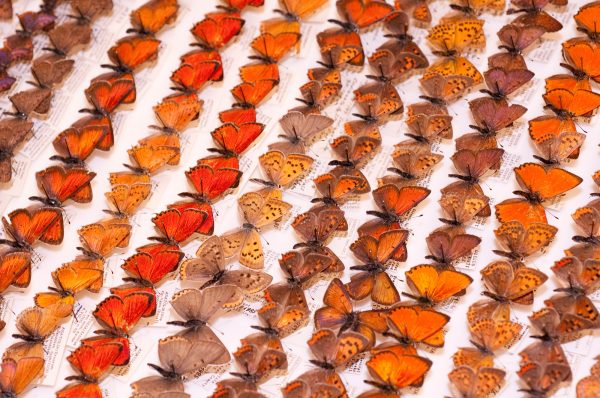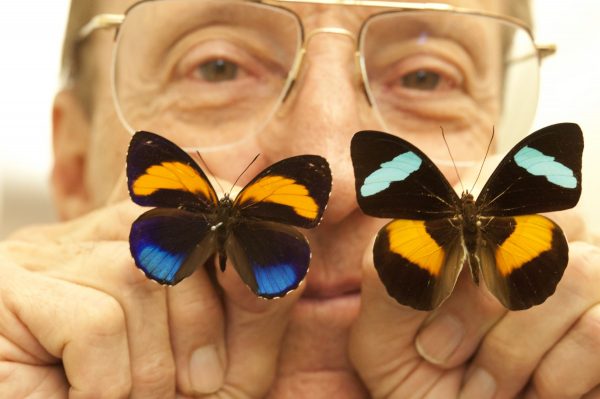A gift of more than 2 million butterfly and moth specimens to the University of Florida contains hundreds and possibly more than 1,000 new unnamed species, and will help researchers better understand biodiversity and environmental changes.

Florida Museum photo by Jeff Gage
The gift to the Florida Museum of Natural History from Dr. William and Nadine McGuire of Wayzata, Minn., is valued at more than $41 million, and also includes funding for curation of the Lepidoptera collection, ongoing taxonomic and biodiversity related research, training of scientists and publication of books and relevant papers. The gift brings the number of specimens in UF’s collection to more than 9 million, one of the world’s largest.
“It is important that both the world’s scientific community and the general public recognize that one of the compelling issues of the early 21st century is the global threat to the present diversity of life on earth,” Bill McGuire said. “It is our belief that this threat to biodiversity demands a stepped-up educational and research effort on the part of universities and governments worldwide.”
UF President Bernie Machen welcomed the McGuires’ gift and said it speaks volumes about the university’s place in environmental studies.
“The McGuires’ support of biodiversity and Lepidoptera research at UF helps solidify the university’s major commitment to understanding and preserving biodiversity and the environment,” Machen said. “This private sector support of global issues is the mark of true, selfless philanthropy.”

Florida Museum photo by Jeff Gage
The Florida Museum of Natural History houses the McGuire Center for Lepidoptera and Biodiversity, named for the McGuires after previous gifts. McGuire Center Director Thomas Emmel said this “unparalleled and unique” gift includes butterflies from every continent except Antarctica, and from geographic sites no longer accessible to scientists.
“The Florida Museum and UF are extremely fortunate that Bill McGuire, who has a lifelong interest in Lepidoptera, knew and recognized the importance of biodiversity and the scientific value of assembling comprehensive collections for taxonomic and other research uses,” Emmel said. “It will take years to completely curate this collection, but we know it contains hundreds, and possibly more than 1,000, species new to science.”
Emmel said Lepidoptera research is critical to the study of the world’s ecosystems because butterflies are good flagship species to assess environmental health.
“An important aspect of the gift is the recognition that the University of Florida now offers the best training and research center in the world for students, postdoctoral fellows and professionals in the many fields that will be using these collections as a database for biodiversity education and research,” Emmel said. “The specimens in the collection represent thousands of rare species, many from locations now destroyed by urban development or rainforest clearing.”
The gift of 2.2 million specimens includes butterflies and moths accumulated during the past 50 years by leading taxonomists, collectors and field biologists throughout the world. It also contains thousands of “type” specimens from which new species were described by specialists as far back as the late 18th and early 19th centuries.

Florida Museum photo by Jeff Gage
“Many of the specimens are irreplaceable samples of extinct species and populations, or were collected from localities where the butterflies no longer live,” said Florida Museum Director Douglas Jones. “The long series of individuals of many species in this collection will allow researchers to study population and genetic variability so important to biodiversity research, unlike the ‘Noah’s ark’ approach of one male and one female seen in some collections. Students and scientists worldwide will visit the museum to work with this unique resource and the incredible database it provides.”
Many ecologists worldwide now use butterfly and moth species as indicators for the overall biodiversity of an ecosystem or plant and animal community.
“Like canaries warning miners of dangerous gases in coal mines, the Lepidoptera are particularly sensitive to poisons in the environment, such as pesticides or heavy metals,” Emmel said. “They are also good indicators of the impact of climate change and global warming on the survival and distribution of animals and plants.”
Although the McGuires did not attend UF, they have a history of strong support for the university. Their earlier contributions include a $4.2 million gift in 2000 for construction of the Lepidoptera facilities at the museum and a live butterfly rainforest exhibit; $3 million to establish the McGuire Center for Lepidoptera and Biodiversity in 2002; and $2.5 million to complete construction of a theater and dance facility on the UF campus in 2004.